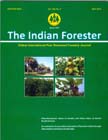Natural Regeneration in Santalum Album Linn: a Case Study from Campus of forest Training Institute, Gungargatti, Dharwad, Karnataka
DOI:
https://doi.org/10.36808/if/2012/v138i4/4643Keywords:
Gungaragatti, Ecosystem, Regeneration and SandalAbstract
Santalum album Linn. is partial root parasite in nature and hence requires host plant for its regeneration and establishment. A study was conducted to observe the regeneration status of sandal under different plant ecosystems. Distribution of natural regeneration of sandal was found to be statistically significant among different ecosystems studied. The overall regeneration was highest in medicinal plant garden, followed by natural forest and bamboo plantations. Considering the different stages of plant growth, plants (seedlings) belongs to the class less than one meter height showed maximum count in all the ecosystems with overall per cent of 69.9, followed by plants (saplings) belongs to 1 to 2 m height (26.0%) and least in plants with more than 2 m height (4.2%). The overall result indicated that, regeneration and establishment of sandal is greatly influenced by availability of seed bearing mother plants in the area, seed dispersal agents, host plants and their nature, fire, grazing and browsing, site conditions and degree of protection provided.Downloads
Download data is not yet available.
Downloads
Published
2012-04-01
How to Cite
Hanumantha, M., Gunaga, R. P., Patil, R. S., , N., & Biradar, S. S. (2012). Natural Regeneration in <I>Santalum Album</I> Linn: a Case Study from Campus of forest Training Institute, Gungargatti, Dharwad, Karnataka. Indian Forester, 138(4), 386–389. https://doi.org/10.36808/if/2012/v138i4/4643
Issue
Section
Articles
License
Unless otherwise stated, copyright or similar rights in all materials presented on the site, including graphical images, are owned by Indian Forester.





